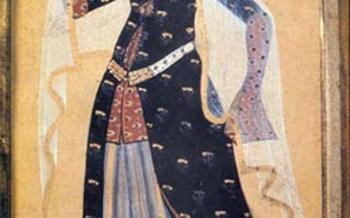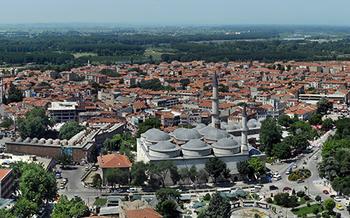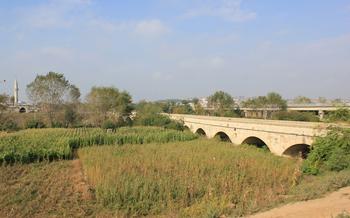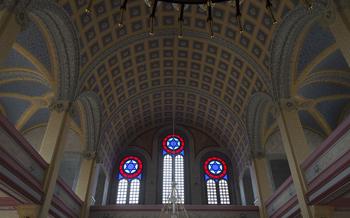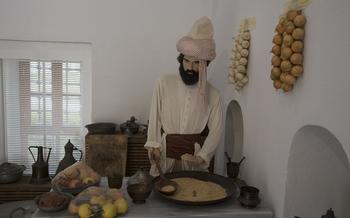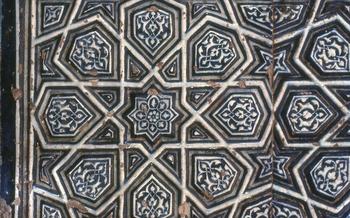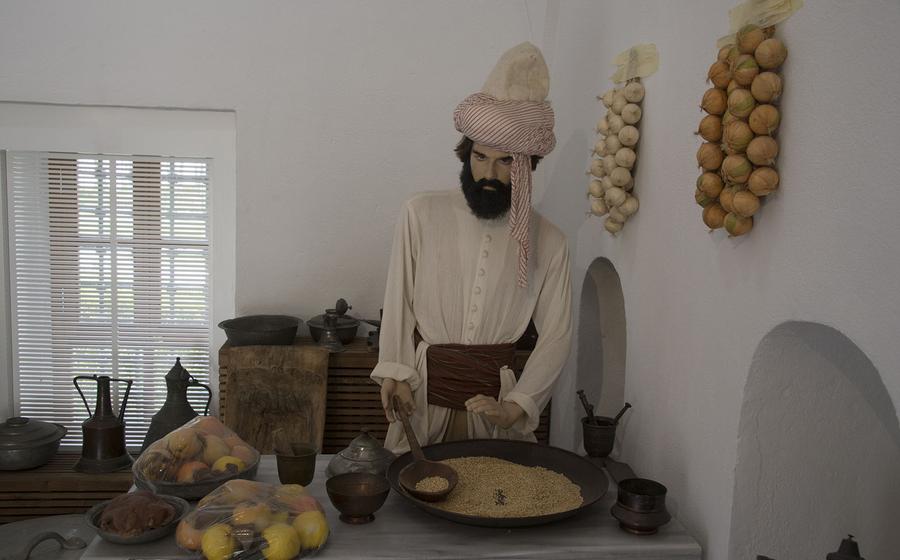
The Health Museum
- Historical Background
- Location and Accessibility:
- Museum Structure and Architecture:
- Exhibits and Collections:
- Pharmacy and Herbal Medicine:
- Surgical Instruments and Techniques
- Medical Education and Training:
- Public Health and Hygiene
- Quarantine and Epidemics
- Medical Ethics and Practices
- Cross-Cultural Influences
- Women in Medicine
- Restoration and Preservation
- Educational Programs and Workshops
- Insider Tip:
Historical Background
Edirne, a city in northwestern Turkey, holds a significant place in the annals of medical history. Once the capital of the Ottoman Empire, Edirne was a hub of medical advancements and innovations that left an enduring legacy on the region. The Health Museum, housed in a beautifully restored 19th-century building, serves as a testament to this rich heritage. Within its walls, visitors can embark on a journey through time, exploring the evolution of healthcare practices and marveling at the ingenuity and dedication of the Ottoman medical pioneers.
The Ottoman Empire, renowned for its vastness and diversity, fostered a vibrant exchange of knowledge and ideas. This intellectual and cultural melting pot gave rise to remarkable medical advancements, blending traditional Islamic practices with influences from ancient Greek, Persian, and Byzantine medicine. The establishment of medical schools and hospitals throughout the empire facilitated the dissemination of medical knowledge and the training of skilled physicians. The Health Museum showcases this remarkable legacy through its extensive collection of medical instruments, artifacts, and documents, providing a glimpse into the world of Ottoman healthcare.
Location and Accessibility:
The Health Museum is conveniently located in the heart of Edirne, a captivating city in northwestern Turkey known for its rich cultural heritage. Its exact address is Şükrü Paşa Caddesi No:44, 22100 Edirne Merkez/Edirne, making it easily accessible for visitors. It is situated within walking distance of several other popular landmarks and attractions in Edirne, including the Selimiye Mosque, a stunning architectural masterpiece, and the Edirne Palace, a historic palace complex that once served as the residence of Ottoman sultans.
To reach the Health Museum, visitors can take advantage of the city's well-connected transportation system. Edirne is well-served by both public buses and taxis, making it easy to get around. Alternatively, visitors who prefer a more leisurely approach can explore the city on foot, immersing themselves in the vibrant atmosphere and taking in the sights and sounds along the way.
Museum Structure and Architecture:
The Health Museum is housed in a magnificent building that reflects the grandeur and opulence of the Ottoman Empire. Constructed in the early 19th century, the building boasts a blend of traditional Ottoman and European architectural styles. Its imposing façade features intricate stone carvings, arched windows, and a grand entrance that invites visitors to step back in time.
Upon entering the museum, visitors are greeted by a spacious and well-lit interior. The building's layout is designed to showcase the diverse collection in a logical and organized manner. Different sections of the museum are dedicated to specific themes or periods, allowing visitors to easily navigate and explore the exhibits.
The museum's architecture also includes several unique and captivating features. The grand staircase, adorned with intricate ironwork and stained-glass windows, is a masterpiece in itself. The building's high ceilings and expansive galleries create a sense of grandeur that enhances the overall museum experience.
Exhibits and Collections:
The Health Museum houses a treasure-trove of medical artifacts and exhibits, providing visitors with a glimpse into the fascinating history of healthcare in the Ottoman Empire. From ancient surgical instruments to intricate anatomical models, the museum's diverse collection offers a comprehensive overview of the region's medical advancements.
One of the highlights of the museum is its display of traditional medical instruments. Visitors can marvel at the precision and craftsmanship of these tools, which were used by skilled physicians to perform surgeries, treat wounds, and diagnose illnesses. The collection includes scalpels, forceps, saws, and other specialized instruments, each with a unique purpose and design.
Interactive displays and educational resources enhance the visitor experience, making the museum an ideal destination for both healthcare professionals and the general public. Visitors can explore interactive exhibits on topics such as anatomy, physiology, and disease, gaining a deeper understanding of the human body and its functions.
The museum also features a section dedicated to traditional pharmacy and herbal medicine, showcasing the importance of natural remedies in Ottoman healthcare. Visitors can learn about the various herbs and plants that were commonly used to treat a wide range of ailments, and how these remedies were prepared and administered.
Pharmacy and Herbal Medicine:
The Health Museum houses a dedicated section to traditional pharmacy and herbal medicine, showcasing the rich knowledge of natural remedies used in Ottoman healthcare. Natural remedies played a vital role in treating various ailments, and the museum exhibits a diverse collection of medicinal plants, herbs, and spices commonly used during that era. Visitors can explore the exhibits to learn about the healing properties of plants like chamomile, thyme, lavender, and valerian, which were used to treat a wide range of conditions. The museum also displays traditional tools and equipment used in the preparation of herbal remedies, offering a glimpse into the practices of Ottoman pharmacists and herbalists.
Surgical Instruments and Techniques
The Health Museum houses an impressive collection of surgical instruments that showcase the remarkable advancements made in surgical techniques during the Ottoman Empire. These instruments, some of which date back centuries, offer a fascinating glimpse into the evolution of surgical practices and the ingenuity of Ottoman physicians. Visitors can marvel at the intricate scalpels, saws, forceps, and other tools that were used to perform complex procedures with precision and skill. The displays also highlight the development of anesthesia and the increasing emphasis on reducing patient suffering during surgery. Notable surgeons associated with the museum include Hekim Ali Pasha, who pioneered the use of gunpowder to cauterize wounds, and Davut Pasha, who was renowned for his expertise in cataract surgery. The museum's collection provides a valuable resource for medical students and professionals, as well as for anyone interested in the history of surgery and the remarkable contributions made by Ottoman surgeons to the field.
Medical Education and Training:
The Health Museum also serves as a valuable resource for medical education and training. It offers a range of educational programs and workshops designed to promote the understanding and appreciation of Ottoman healthcare practices. These programs are open to medical students, healthcare professionals, and the general public, providing a unique opportunity to learn from the rich history of medicine in the region.
One of the most significant aspects of the museum's educational mission is its focus on preserving and passing on medical knowledge to future generations. Through its exhibits, programs, and workshops, the museum aims to inspire young people to pursue careers in healthcare and to instill in them a deep appreciation for the history and traditions of medicine.
The museum's educational programs cover a wide range of topics, including the history of medicine in the Ottoman Empire, the evolution of surgical techniques, the role of natural remedies in healthcare, and the ethical considerations that guided medical professionals. These programs are conducted by experienced educators and healthcare professionals, who share their knowledge and expertise with participants in an engaging and interactive manner.
By offering these educational programs and workshops, the Health Museum plays a vital role in promoting medical education and training, ensuring that the rich legacy of Ottoman healthcare continues to inform and inspire future generations of medical professionals.
Public Health and Hygiene
The Health Museum also delves into the realm of public health and hygiene practices during the Ottoman Empire. Visitors can explore exhibits that showcase the measures taken to prevent and control diseases, ensuring the overall well-being of the population. These exhibits highlight the importance of sanitation, clean water, and proper waste disposal in maintaining a healthy society.
Ottoman cities invested in infrastructure projects to provide clean water sources, such as fountains and aqueducts. Public baths were also prevalent, serving as centers for both physical cleansing and social interaction. The museum showcases replicas of these baths, demonstrating their architectural design and the bathing rituals that took place within.
Furthermore, the museum sheds light on the Ottoman Empire's response to epidemics. Quarantine practices were implemented to prevent the spread of infectious diseases, particularly during periods of outbreaks. Visitors can learn about the establishment of quarantine stations and the protocols followed to isolate and treat individuals who were potentially infected.
These exhibits not only provide a glimpse into the historical approaches to public health but also underscore the enduring significance of these practices in contemporary society. Understanding the evolution of public health measures in the Ottoman Empire offers valuable insights for modern healthcare systems and disease prevention strategies.
Quarantine and Epidemics
The Health Museum in Edirne also sheds light on the intricate and crucial measures taken during times of quarantine and epidemics. In the wake of infectious disease outbreaks, quarantine emerged as a vital strategy to prevent their rampant spread. The museum presents a detailed account of the quarantine process, highlighting its significance in safeguarding public health.
Within the museum's dedicated section, visitors can delve into the meticulous procedures implemented to contain epidemics. Stringent protocols for isolation and disinfection were meticulously followed to minimize transmission and protect vulnerable populations. The exhibits provide insights into the challenges faced by healthcare professionals and authorities during these perilous times.
The museum also chronicles notable epidemics that struck the region, including cholera and bubonic plague. Visitors can learn about the devastating impact of these diseases and witness the extraordinary measures undertaken to combat their spread. These historical accounts serve as a poignant reminder of the fragility of public health and the tireless efforts made to protect communities from infectious threats.
Medical Ethics and Practices
Medical ethics and practices played a crucial role in shaping the healthcare system of the Ottoman Empire. Physicians were guided by a strong sense of ethical responsibility towards their patients. Patient confidentiality was highly valued, and medical practitioners were expected to maintain the privacy of their patients' information. The concept of informed consent was also recognized, and patients were generally informed about the nature of their illness and the proposed treatment before any procedures were carried out. Ethical principles such as beneficence, non-maleficence, and justice were upheld, ensuring that patients received the best possible care while minimizing any potential harm. These ethical considerations were deeply ingrained in the medical culture of the Ottoman Empire and continue to influence healthcare practices in the region to this day.
Cross-Cultural Influences
The Ottoman Empire, being a crossroads of civilizations, witnessed a rich exchange of medical knowledge and practices with neighboring regions. This cross-cultural pollination greatly influenced the development of Ottoman healthcare. Physicians and scholars from different parts of the world, including Persia, India, and Europe, contributed to the advancement of medical practices in the empire. For instance, the influence of Islamic medicine, with its emphasis on herbal remedies and holistic healing, played a significant role in shaping Ottoman medical practices. Additionally, the empire's interactions with European powers led to the introduction of new medical technologies and techniques, further enriching the existing healthcare system. This exchange of knowledge and ideas fostered a vibrant and diverse medical landscape that continues to shape healthcare practices in the region to this day.
Women in Medicine
During the Ottoman period, women played a significant role in healthcare, although their contributions have often been overlooked. Female healers known as "tabibes" or "hekim kadınları" provided medical care to women and children, particularly in areas where male doctors were not readily available. These women were often skilled in herbal medicine, midwifery, and other traditional healing practices.
Despite the challenges they faced in a male-dominated society, some women managed to achieve recognition and make significant contributions to the field. One notable figure was Fatma Hatun, a physician who served as the personal doctor to the sultan's harem in the 16th century. She was known for her expertise in obstetrics and gynecology and was highly respected for her medical skills.
The Health Museum in Edirne pays tribute to the contributions of women in medicine through exhibits and displays that showcase the roles and achievements of female healers and practitioners. Visitors can learn about the challenges and opportunities these women faced and gain insights into the diverse roles they played in Ottoman healthcare.
Restoration and Preservation
The Health Museum underwent extensive restoration and preservation efforts to restore its former glory and ensure its longevity. The process involved meticulous attention to detail, using traditional techniques and materials to maintain the building's historical integrity.
One of the challenges faced during the restoration was the need to balance authenticity with modern requirements. While preserving the original features, the museum had to incorporate modern amenities and accessibility measures to enhance the visitor experience.
The efforts paid off as the restored Health Museum now stands as a testament to the enduring legacy of Ottoman healthcare. It continues to serve as a valuable resource for researchers, scholars, and the general public, providing insights into the rich medical heritage of the region.
Educational Programs and Workshops
The Health Museum offers a range of educational programs and workshops designed to engage and inform visitors of all ages. These programs aim to promote health awareness, foster a deeper understanding of medical history, and provide hands-on learning experiences.
One of the most popular programs is the "History of Medicine Workshop," which takes participants on a journey through the evolution of healthcare practices from ancient times to the present day. Participants get to examine replica medical instruments, handle historical artifacts, and learn about the advancements that have shaped modern medicine.
For those interested in natural remedies, the museum offers a "Traditional Pharmacy Workshop." Participants learn about the use of herbs and plants in Ottoman healthcare and get to create their own herbal remedies using traditional methods.
The museum also hosts regular lectures, seminars, and conferences on various medical topics. These events provide a platform for experts and scholars to share their knowledge and insights with the public, fostering a vibrant exchange of ideas and perspectives.
These educational programs and workshops are a valuable resource for students, healthcare professionals, and anyone interested in learning more about the fascinating world of medical history. They offer a unique opportunity to engage with the past and gain a deeper appreciation for the advancements that have led to modern healthcare.
Insider Tip:
To make the most of your visit to the Health Museum, plan your trip to coincide with one of their special events or exhibitions. These events often feature guest speakers, interactive demonstrations, or themed displays that provide a deeper dive into specific aspects of Ottoman healthcare. Check the museum's website or social media pages for upcoming events and exhibitions.
After exploring the museum, take a short walk to the nearby Selimiye Mosque, a stunning architectural masterpiece known for its intricate tilework and towering minarets. For a culinary treat, indulge in some traditional Turkish delights at one of the many cafes or restaurants lining the cobblestone streets of the old city. The Tarihi Odun Pazarı Çarşısı (Historical Wood Market Bazaar) is a great place to find authentic souvenirs and handicrafts.

